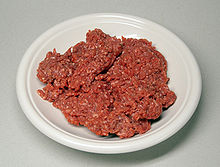Minced meat
Minced meat , even minced , minced (österr.), Gewiegtes , Mett or hash , is more or less finely chopped coarsely entsehntes muscle meat , that the only adding more than 1% salt may contain. Today it is no longer chopped or weighed with a knife , but made using a meat grinder . Since the muscle fibers are severely chopped up, it cooks much faster than whole pieces of meat and can also be eaten raw. Raw minced meat is perishable very quickly due to the increased surface area and partially destroyed cell membranes .
Manufacturing
Minced meat is mainly made from raw pork , beef and veal , mutton and lamb , game and poultry or mixed cooked leftover meat or sausage leftovers (cuts or sausage ends).
- Pork and minced beef are most common in Germany, often half and half mixed. Minced pork may contain a maximum of 30% fat and minced beef a maximum of 20% fat. The mince mixed from it may also contain a maximum of 30% fat. The specified fat contents are based on EU requirements for the designation of minced meat in Regulation (EU) No. 1169/2011.
- Thuringian minced meat (minced meat, Mett, Thuringian Mett, Hackepeter) is a seasoned minced pork meat. The various names can have different meanings from region to region. The maximum fat content is 30%.
- Schabefeat or Beefsteakhack is made from tendon-free and low-fat beef muscle meat such as B. Upper shell (with very fine scraped meat also the ends of the fillet ) and is finely chopped up than simple minced meat. It is mainly eaten raw as a beef steak tartare . The maximum permissible fat content is 7%.
- Tartar is originally only beef fillet ( fillet beef steak), but very lean beef from other cuts is also used, with a maximum of 6% fat being customary
- Minced lamb plays a role especially in oriental or oriental-influenced cuisine ( Köfte ).
- Game and minced poultry may be produced and sold raw in all meat processing companies after the minced meat ordinance has been repealed. Because of the danger of trichinae or salmonella, it was not previously allowed to be given to end users in the raw state.
Examples of minced meat dishes are meatballs , Königsberger Klopse and meat loaf ; Often used as a filling e.g. B. in cabbage rolls and stuffed peppers. Numerous types of sausage are made from minced meat, for example the Thuringian Rostbratwurst .
EU minced meat
EU minced meat is minced meat that is produced in companies with a special EU approval under special hygienic requirements. It is usually packed in a protective atmosphere . This gas mixture consists of oxygen and carbon dioxide . Due to the proportion of oxygen, the red color of the meat is retained longer, the gray coloring is slowed down, and the proportion of carbon dioxide in the pack inhibits the growth of microorganisms. The minced meat can be kept for a few days longer. The use-by date for EU mince can be determined by storage tests by the manufacturer itself, it refers to a storage temperature of not more than 2 ° C . This temperature is normally not reached in normal household refrigerators with their storage temperature of 4–7 ° C. Special cooling or freezing compartments are required for this.
Food hygiene
The handling of minced meat is regulated in the Federal Republic of Germany in the Animal Food Hygiene Regulation (Tier-LMHV) of August 8, 2007. This ordinance for the implementation of provisions of Community food hygiene law contains and replaces the provisions of the former minced meat ordinance . Fresh minced meat may then only be sold on the day of production.
Escherichia coli , salmonella and listeria are among the bacteria that grow relatively easily in minced meat and can cause disease in humans . In order to hinder the reproduction of bacteria and thus also to increase the shelf life, attempts are being made to add lactic acid bacteria to industrial production, as is the case with yoghurt and cheese . The effectiveness of methods developed in the USA in which ammonia is added to minced meat to kill bacteria is controversial.
The Stiftung Warentest has mixed minced meat (half beef, half pork) in 2015 investigated and the results in the issue 2/2015 of test (Journal) published. Half of the products tested contained germs such as Escherichia coli (also known as E. coli bacteria) and salmonella . In 8 out of 21 cases, the testers also came across antibiotic- resistant germs.
Individual evidence
- ↑ Regulation (EU) No. 1169/2011 (Food Information Regulation) , accessed on April 8, 2016 . Annex VI, Part B, No. 1.
- ↑ Herings Lexicon of the Kitchen, 25th edition, page 41
- ↑ Animal Food Hygiene Ordinance , Federal Law Gazette I p. 1816.
- ↑ Center for Infectious Disease Research & Policy, University of Minnesota: Antibacterial bacteria may be used in ground beef (engl., Antibacterial bacteria could be used in ground beef ) April 27, 2006.
- ^ Safety of Beef Processing Method Is Questioned .
- ↑ Minced meat in the test: Bio beats conventionally , test.de , January 29, 2015, accessed on February 4, 2015.
